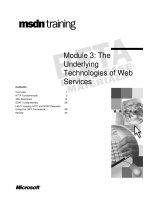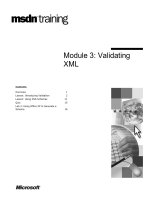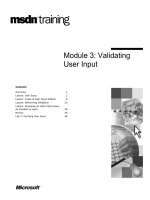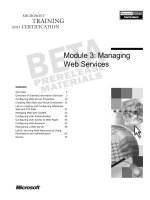Tài liệu Module 3: Organizing Product Information docx
Bạn đang xem bản rút gọn của tài liệu. Xem và tải ngay bản đầy đủ của tài liệu tại đây (1.21 MB, 36 trang )
Contents
Overview 1
Lesson: Introduction to Master Content
Sources 2
Lesson: Selecting a Master Content Source
Design 9
Lesson: Establishing a Data Migration
Process 16
Review 25
Lab A: Organizing Product Information 27
Module 3: Organizing
Product Information
Information in this document, including URL and other Internet Web site references, is subject to
change without notice. Unless otherwise noted, the example companies, organizations, products,
domain names, e-mail addresses, logos, people, places, and events depicted herein are fictitious,
and no association with any real company, organization, product, domain name, e-mail address,
logo, person, place or event is intended or should be inferred. Complying with all applicable
copyright laws is the responsibility of the user. Without limiting the rights under copyright, no
part of this document may be reproduced, stored in or introduced into a retrieval system, or
transmitted in any form or by any means (electronic, mechanical, photocopying, recording, or
otherwise), or for any purpose, without the express written permission of Microsoft Corporation.
Microsoft may have patents, patent applications, trademarks, copyrights, or other intellectual
property rights covering subject matter in this document. Except as expressly provided in any
written license agreement from Microsoft, the furnishing of this document does not give you any
license to these patents, trademarks, copyrights, or other intellectual property.
2001 Microsoft Corporation. All rights reserved.
Microsoft, Windows, BackOffice, BizTalk, FrontPage, Hotmail, PowerPoint, Visual Basic,
Visual C++, Visual Studio, and Windows Media are either registered trademarks or trademarks of
Microsoft Corporation in the United States and/or other countries.
The names of actual companies and products mentioned herein may be the trademarks of their
respective owners.
Module 3: Organizing Product Information iii
Instructor Notes
This module examines the importance of collecting and organizing product
information into a single electronic format for the creation of online catalogs.
By using a single electronic format, also called a master content source,
students can create customized catalogs for their business-to-business (B2B)
trading partners with relative ease and speed.
After completing this module, students will be able to:
!
Describe a master content source and explain its benefits.
!
Design a master content source.
!
Establish a data migration process.
To teach this module, you need Microsoft
®
PowerPoint
®
file 2420A_03.ppt.
To prepare for this module:
!
Read all of the materials for this module.
!
Complete the practices and lab.
Presentation:
90 minutes
Lab:
45 minutes
Required materials
Preparation tasks
iv Module 3: Organizing Product Information
How to Teach This Module
This section contains information that will help you teach this module.
Lesson: Introduction to Master Content Sources
This lesson introduces the concept of a master content source as a single
electronic repository for product information. Explain to students the benefits of
using a master content source, and how it enables the design and creation of
custom electronic catalogs for trading partners. Ensure that students understand
that the primary purpose of a master content source is to create catalogs.
The following information is specific to individual pages in this lesson.
This page is not intended to be a comprehensive or definitive source on what
information to include in a master content source. The type of information that
an organization includes in the master content source depends completely on
the organization’s business needs.
Spend about 10 minutes on each practice in the module. The answers that are
provided for each practice are suggested answers only. Students may develop
their own reasons for including or excluding attributes from their design.
Encourage class discussion, and feel free to change the practice parameters to
increase discussion.
Lesson: Selecting a Master Content Source Design
Students must choose a storage method for their master content source. Discuss
the capabilities of the examples provided and the considerations for choosing a
storage method.
The following information is specific to individual pages in this lesson.
This page merely presents examples of storage methods. Do not spend time
discussing which method to choose; save that discussion for the next page.
Emphasize that because a master content source is a new entity, students must
ensure that, as part of their design, they determine how it will be managed.
Lesson: Establishing a Data Migration Process
When designing a plan to implement a master content source, students must
define a data migration process. Even in medium-size environments, the
process can be very complicated, often involving aggregation, synchronization,
and restructuring of data. Avoid a lengthy discussion of specific migration
methods unless it is appropriate.
The following information is specific to individual pages in this lesson.
This summary page highlights the main design elements of the module. It is
meant as a simple module review and a tool to help students prepare for the
final module and lab, where they analyze a new scenario and create a B2B
integration design plan.
Guidelines for Including
Information in a Master
Content Source
Practice
Types of Storage
Methods
Considerations for
Managing a Master
Content Source
Summary: Organizing
Content
Module 3: Organizing Product Information v
Lab: Organizing Product Information
In this design lab, students study how Adventure Works maintains product
information and creates catalogs for trading partners. Students answer design
questions about the creation of a master content source and the migration of
product data to it.
If students consider Microsoft Excel to be a requirement in the scenario, remind
them that, if possible, the sales team wants to continue using only Excel
because the team is already trained and familiar with the product. However,
because of the security requirements of the project, Excel may not be a viable
option. Students should include training on the new method of updating product
information in their overall design.
The design lab is scheduled for 45 minutes. Divide students into pairs or small
teams, and ask them to spend 20 minutes reading and discussing the scenario.
Then, have each pair or team present its answers to the class.
Although the lab scenario provides a clear path to certain design decisions, it
contains enough ambiguity to encourage student discussion and debate.
Students may disagree with the answers that are provided in the Delivery Guide
and the Student Materials compact disc. Disagreement is acceptable if students
can provide adequate business or technical justification. To increase student
involvement, ask a representative of each team to present the team’s answers to
the class and then defend the design.
Customization Information
This section identifies the lab setup requirements for a module and the
configuration changes that occur on student computers during the labs. This
information is provided to assist you in replicating or customizing Microsoft
Official Curriculum (MOC) courseware.
This module contains a single paper-based design lab. There are no hands-on
labs in this module, and as a result, there are no lab setup requirements or
configuration changes that affect replication or customization.
Timing
Discussion
Module 3: Organizing Product Information 1
Overview
!
Introduction to Master Content Sources
!
Selecting a Master Content Source Design
!
Establishing a Data Migration Process
Supplier
Supplier
Master
Content
Source
Master
Master
Content
Content
Source
Source
Product
Information
Product
Information
*****************************
ILLEGAL FOR NON
-
TRAINER USE
******************************
Your organization maintains content that describes your products. Content
includes product attributes that help describe a product, such as color,
dimension, and price. These attributes are often useful to a trading partner.
You use electronic catalogs to list products and their descriptions for trading
partners. Because trading partners often have different needs and require
catalogs in different formats, it may be necessary to create a separate catalog for
each trading partner. To simplify the process of creating and maintaining
multiple catalogs, you can collect your product information in a single location,
called a master content source, and then use this single source as a staging area
for catalog creation.
Before you create a master content source, collect the product information that
you use in your catalogs from the various locations where the information
resides. Next, choose a storage method, such as a Microsoft
®
SQL Server
™
2000 database. After you create your master content source,
migrate your content to it. Ensure that you establish management procedures
and create update schedules for your master content source so that content
remains current and accurate.
After completing this module, you will be able to:
!
Describe a master content source and explain its benefits.
!
Design a master content source.
!
Establish a data migration process.
Introduction
Ob
jectives
2 Module 3: Organizing Product Information
Lesson: Introduction to Master Content Sources
!
Where Is Information Currently Stored?
!
What Is a Master Content Source?
!
Reasons to Use a Master Content Source
!
Guidelines for Including Information in a Master
Content Source
!
Practice: Choosing Information to Include in a Master
Content Source
*****************************
ILLEGAL FOR NON
-
TRAINER USE
******************************
Catalogs include products and their descriptions. Because product information
often exists in several locations, creating an electronic catalog can be difficult.
Also, not all trading partners require or want the same type of information. You
can use a master content source to create a custom catalog for each of your
trading partners from the same central data source.
After completing this lesson, you will be able to:
!
Identify the locations of content.
!
Describe a master content source.
!
Explain the reasons to use a master content source.
!
Determine the types of information to include in a master content source.
Introduction
Lesson ob
jectives
Module 3: Organizing Product Information 3
Where Is Information Currently Stored?
ERP
System
Paper
Catalog
SQL Server
Database
Other Sources
Flat File
SQL Server
SQL Server
Existing data may be located in:
"
Multiple locations
"
Multiple formats
"
Nonelectronic formats
Personnel
*****************************
ILLEGAL FOR NON
-
TRAINER USE
******************************
Before you collect your product information in a central source, identify the
location of all relevant information.
For each product that you offer in a catalog, you must locate all of the
information that describes it. For example, your main office may update
product description and sales information, which your regional office uses. But
your regional office may maintain specific production information that only
your trading partners in that region require.
Even within a single geographic location, separate databases or business
systems may store information about a product. For example, a Material
Resource Planning (MRP) system may contain ordering information, but an
Enterprise Resource Planning (ERP) system may contain the pricing data.
It is possible that you also store information in one or more electronic formats,
such as:
!
Catalogs distributed on electronic media. Examples include compact discs,
digital video discs, and tapes.
!
Flat files. Examples include Microsoft Word XP documents, Microsoft
Excel XP spreadsheets, and comma-separated value (CSV) files.
!
Electronic databases. Examples include Microsoft Access 2000 and
SQL Server 2000.
Your organization may also store information in nonelectronic or nontraditional
formats, such as paper catalogs, or in more informal places, such as paper
newsletters, electronic mail archives, or the memories of individuals.
Introduction
Identify content
locations
Identify content formats
Identify nonelectronic
formats
4 Module 3: Organizing Product Information
What Is a Master Content Source?
A master content source provides:
"
A staging area for catalog information
"
A consistent source for information
"
Easy access to information
price
price
model
model
SKU
SKU
warranty
warranty
weight
weight
height
height
139.99
139.99
M-990
M-990
23654
23654
1
1
2.5
2.5
9.0
9.0
139.99
139.99
M-990+
M-990+
23656
23656
1
1
2.5
2.5
9.0
9.0
139.99
139.99
M-998
M-998
23657
23657
1
1
2.75
2.75
8.5
8.5
159.99
159.99
N-800
N-800
23658
23658
2
2
1.8
1.8
6.0
6.0
169.99
169.99
N-880
N-880
23659
23659
1
1
1.8
1.8
6.0
6.0
169.99
169.99
N-880+
N-880+
23660
23660
1
1
1.9
1.9
6.0
6.0
179.99
179.99
N-900
N-900
23661
23661
2
2
2.0
2.0
5.5
5.5
Master Content Source
Existing Product Information
Existing Product Information
Existing Product Information
*****************************
ILLEGAL FOR NON
-
TRAINER USE
******************************
Creating a master content source can solve problems that are associated with
the maintenance of product information in many locations.
A master content source is a single electronic source for product information.
You use a master content source as an electronic staging area to create catalogs
and as a single source for centralizing product information.
A master content source separates product information from catalog creation.
This separation helps ensure that product data is accurate in all of your catalogs.
For example, if multiple catalogs reference the same product, and you do not
use a master content source, you must update each catalog whenever a product
attribute changes. However, if you collect product information in a master
content source, you update the information in a single location.
Centralizing product information enables you to create catalogs from a
consistent, complete, and reliable source. Discrepancies can occur if you pull
product information from its original location into a catalog, especially when
you maintain the same information in multiple locations. If you do not
synchronize information among all locations, you may inadvertently pull
outdated information into a catalog.
By including all of the information that you require for your electronic catalogs
in a master content source, you and others in your organization can gain easy
access to the information and update it.
Introduction
Definition
Staging area for catalog
information
Consistent source for
information
Easy access to
information
Module 3: Organizing Product Information 5
Reasons to Use a Master Content Source
Use a master content source to:
"
Enable the design of customized catalogs
"
Enable the rapid creation of catalogs
"
Ensure consistent attribute values
price
price
model
model
SKU
SKU
warranty
warranty
weight
weight
height
height
139.99
139.99
M-990
M-990
23654
23654
1
1
2.5
2.5
9.0
9.0
139.99
139.99
M-990+
M-990+
23656
23656
1
1
2.5
2.5
9.0
9.0
139.99
139.99
M-998
M-998
23657
23657
1
1
2.75
2.75
8.5
8.5
159.99
159.99
N-800
N-800
23658
23658
2
2
1.8
1.8
6.0
6.0
169.99
169.99
N-880
N-880
23659
23659
1
1
1.8
1.8
6.0
6.0
169.99
169.99
N-880+
N-880+
23660
23660
1
1
1.9
1.9
6.0
6.0
179.99
179.99
N-900
N-900
23661
23661
2
2
2.0
2.0
5.5
5.5
Master Content Source
Electronic Catalog
for Trading Partner 1
Electronic Catalog
for Trading Partner 2
*****************************
ILLEGAL FOR NON
-
TRAINER USE
******************************
A master content source provides several benefits to catalog creation.
You can create catalogs that are tailored to the specific needs of your trading
partners. For example, a supplier creates two catalogs: one catalog for an
industrial company and another catalog for a marketplace. The catalog for the
industrial company excludes products that it does not use; it also excludes
prices, which the supplier negotiates with the company directly. The catalog for
the marketplace includes more products and lists prices, but it excludes other
attributes that the marketplace does not permit.
An organization must be able to create catalogs rapidly to respond to changes in
market conditions and trading partner requirements. By storing all product
information in a single location, you can make changes faster and ensure that
your catalogs promptly reflect those changes.
Creating catalogs from multiple data locations can lead to inconsistencies in
how you describe products to trading partners. A master content source
eliminates inconsistency by ensuring that all of the attributes for a product are
described in a similar way.
Suppose an automobile company maintains data about a specific car engine in
both a spreadsheet and a database. The sales contact for one trading partner
creates his catalog from the spreadsheet, but the contact for a second trading
partner creates her catalog from the database. If the spreadsheet and database do
not describe the engine exactly the same way, one of the trading partners may
receive different or even outdated information.
Introduction
Create customized
catalogs
Create catalogs rapidly
Describe attributes
consistentl
y
6 Module 3: Organizing Product Information
Guidelines for Including Information in a Master Content Source
Omit information that
Omit information that
Omit information that
Examples
Examples
Examples
Is not related to catalog creation
Is not related to catalog creation
# Warehouse bin number
# Sales contacts
# Addresses
# Warehouse bin number
# Sales contacts
# Addresses
Include information that
Include information that
Include information that
Examples
Examples
Examples
Benefits the buyer
Benefits the buyer
# Product information
# Industry codes
# Graphics
# Customer part number
# Product information
# Industry codes
# Graphics
# Customer part number
Benefits the supplier
Benefits the supplier
# Cost center
# Internal part number
# Cost center
# Internal part number
*****************************
ILLEGAL FOR NON
-
TRAINER USE
******************************
The information that you choose to include in your master content source
depends on its usefulness to your trading partners and to your organization.
Your trading partners use the information in your electronic catalog to purchase
products that best suit their needs. Therefore, include attributes that describe
products accurately and that are relevant to your trading partners. Also include
specific information that your trading partners may require, such as part
numbers or reference codes that the trading partner uses internally, or industry
codes that they use to identify parts. You can also include information that
trading partners are not asking for specifically but that help differentiate
products, such as graphics.
As a supplier, you may decide to store product information in the master
content source that serves your business purposes but that is not intended for
catalog content. For example, you can include internal billing information about
a specific product. Before you include extra information, however, identify who
will have access to the master content source and determine whether including
the information will duplicate maintenance efforts elsewhere.
Because you will use the master content source primarily to create catalogs, it is
generally recommended that you restrict its contents to product-specific
information. Exclude other information, such as names and contact information
of sales representatives, accounting costs, and warehouse bin location numbers,
that your organization maintains elsewhere or that has little to do with catalog
creation.
Introduction
Include beneficial
information
Omit irrelevant
information
Module 3: Organizing Product Information 7
Practice: Choosing Information to Include in a Master Content
Source
1. Read the scenario
2. Analyze the products and associated
information
3. Choose what information to include
in your master content source
4. Discuss your decisions
1. Read the scenario
2. Analyze the products and associated
information
3. Choose what information to include
in your master content source
4. Discuss your decisions
Discussion
Discussion
Discussion
*****************************
ILLEGAL FOR NON
-
TRAINER USE
******************************
This practice presents a company that is designing a master content source for
online business. Read the scenario, answer the questions, and then briefly
discuss your answers with your classmates.
A lumber company offers products to general contractors and large construction
companies. The lumber company wants to expand its sales to overseas markets.
The company recently purchased a Customer Resource Management (CRM)
application to maintain sales information for product listings.
Complete the following table, and then answer the questions.
Attribute Include Do not include
Product dimensions X
Grade X
Weight X
Warehouse bin number X
Shipping hub X
Sales contact information X
Product name X
Internal accounting
reference number
X
International industry code X
Product description X
Processing plant X
Introduction
Scenario
8 Module 3: Organizing Product Information
1. What product attributes would you consider including in the master content
source, and who would benefit from the attributes?
Include attributes that directly benefit buyers, which include all
attributes in the CRM except for the warehouse bin number, processing
plant, internal accounting reference number, and sales contact
information. All of the other attributes are related to the product or
may be useful to buyers. For example, shipping hubs may be useful for
buyers if the location affects shipping costs.
2. What attributes would you choose not to include, and why?
Warehouse bin number and sales contact information. This information
is irrelevant to buyers, is tracked elsewhere, and is likely to change
frequently.
The internal accounting reference number and the location or name of
the processing plant benefit the supplier, but are not directly related to
catalog creation. You could include these attributes, but they are likely
to be maintained elsewhere.
Questions









